Skye’s history is a tapestry woven with tales of resilience, conquest, and cultural revival, from prehistoric settlers to the power struggles of medieval clans.
Understanding the history of a place you travel to will enrich your experience. So many of the wonderful things to see in Skye are in the outdoors, but learning about the history of some of these areas will help you see them as more than just scenic sites; they are also important places in the history of Skye and Scotland.
I really think it’s a shame when visitors see only the surface level of Skye without delving into its past.
Here are 10 key things to know, or times in the past, that can help us understand the rich history of the Isle of Skye. Where applicable, I’ve also included places that you can visit now to immerse yourself in these periods of Skye’s history.
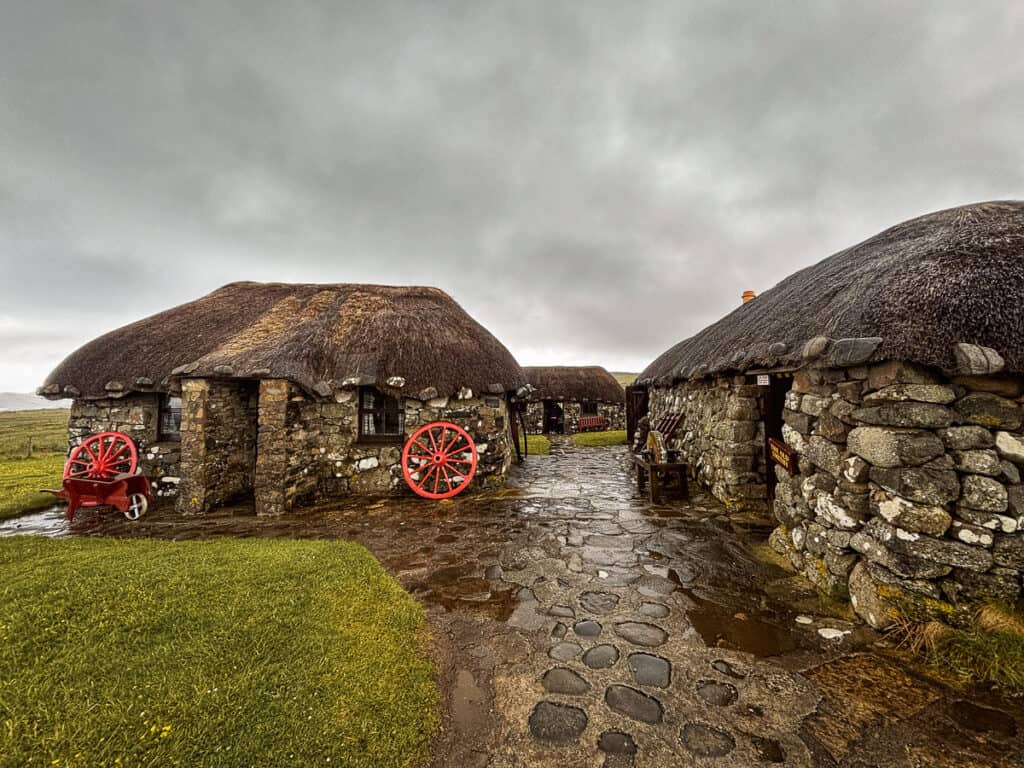
1. Dinosaurs on Skye
Long before humans arrived on the Isle of Skye, this ancient land was home to some of the earliest dinosaurs. Skye has revealed an exceptional collection of fossils, including the footprints and bones of long-necked sauropods and sharp-toothed theropods dating back to the Middle Jurassic period, around 170 million years ago.
These remarkable discoveries have positioned Skye as one of the most important dinosaur sites in Scotland and the world. They are not commonplace, making Skye a unique place in the world in terms of the history of dinosaurs.
These findings have provided valuable insights into ancient Scotland’s diverse dinosaur life and the environment, which was once a subtropical lagoon.
There are three known sites for dinosaur footprints on Skye:
An Corran (Staffin): The prints here are the most accessible, as they are just next to the beach slipway and visible from mid-low tide.
Brother’s Point: The footprints here are a bit harder to find but also viewable at low tide.
Duntulm Castle: A row of footprints can be seen below the castle at low tide.
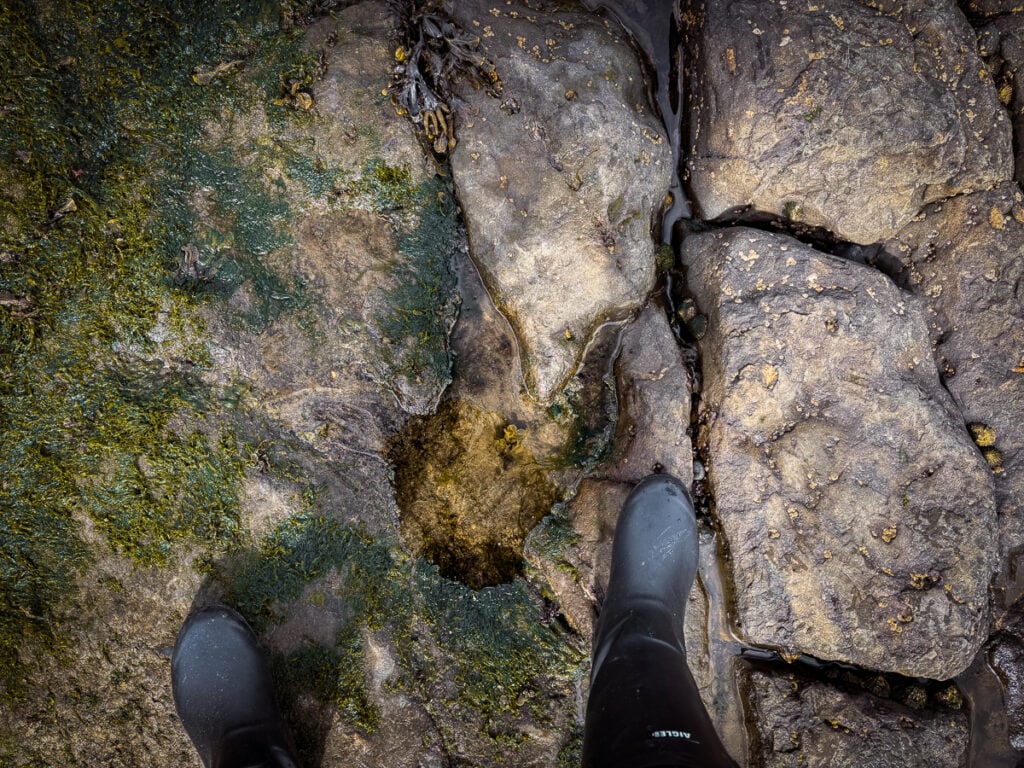
2. Prehistoric Skye
Centuries before the arrival of the Scots, Norsemen, or the clans, Skye was inhabited by prehistoric peoples.
Archaeologists have found tools, pottery, and the remains of ancient structures, indicating that humans have lived on Skye for thousands of years.
Rubha an Dùnain, a now uninhabited peninsula south of the Cuillin hills, accessible from Glenbrittle, includes ancient stone-built chambers and a passage grave. These are evidence of early settlers who relied on the land and sea, laying the groundwork for Skye’s human history.
The climate, terrain, and natural resources would have been crucial in shaping the lives and societies of these early inhabitants.
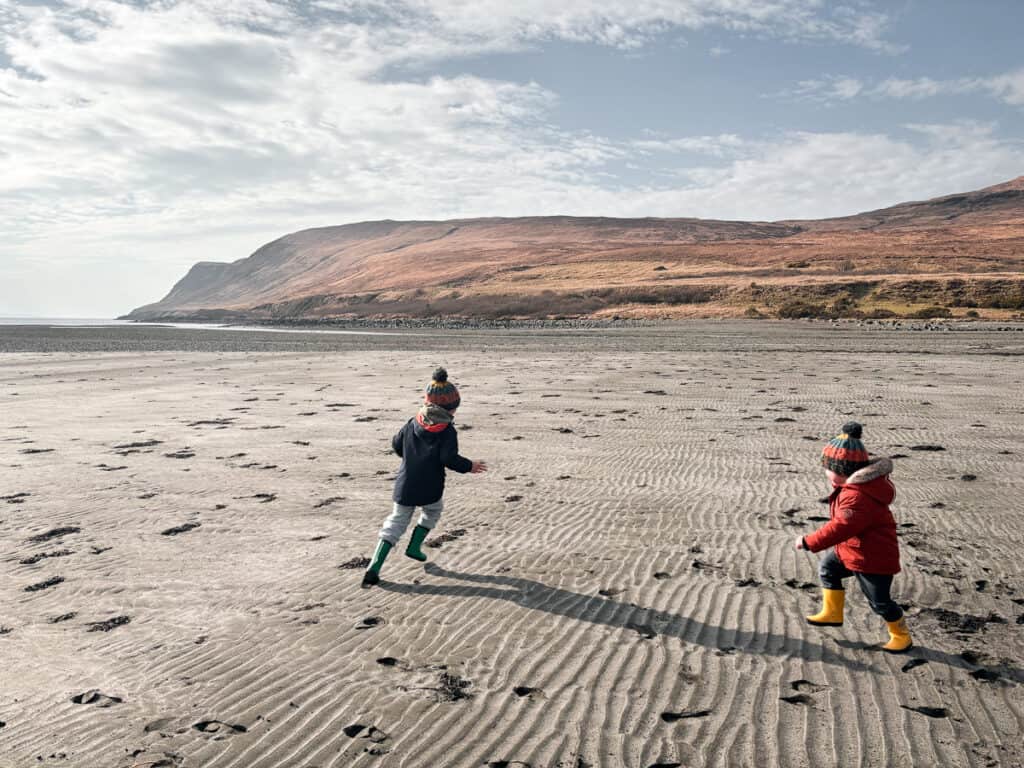
3. The Picts and Early Settlements
The Picts, a confederation of tribes known for their warrior culture, painted bodies, and unique stone carvings, once inhabited Skye and the surrounding Scottish Highlands.
The Pictish influence remains visible in the island’s early settlements, place names, and standing stones.
The circular stone towers of brochs, unique to Scotland, served as dwellings and defensive strongholds. They provide a glimpse into the lives of these ancient people, who built defensive structures to protect against invaders and rival tribes. Many of these are around Skye, including Dun Beag, the most accessible to visit, located near Struan.
Few Pictish symbol stones have been found in the west of Scotland, but three have been found in Skye. You can see one near Tote, northwest of Portree. There is also one on the nearby Isle of Raasay.
The scarcity of written records means much of Pict history remains a mystery. Still, the archaeological evidence on Skye helps piece together something of their way of life.
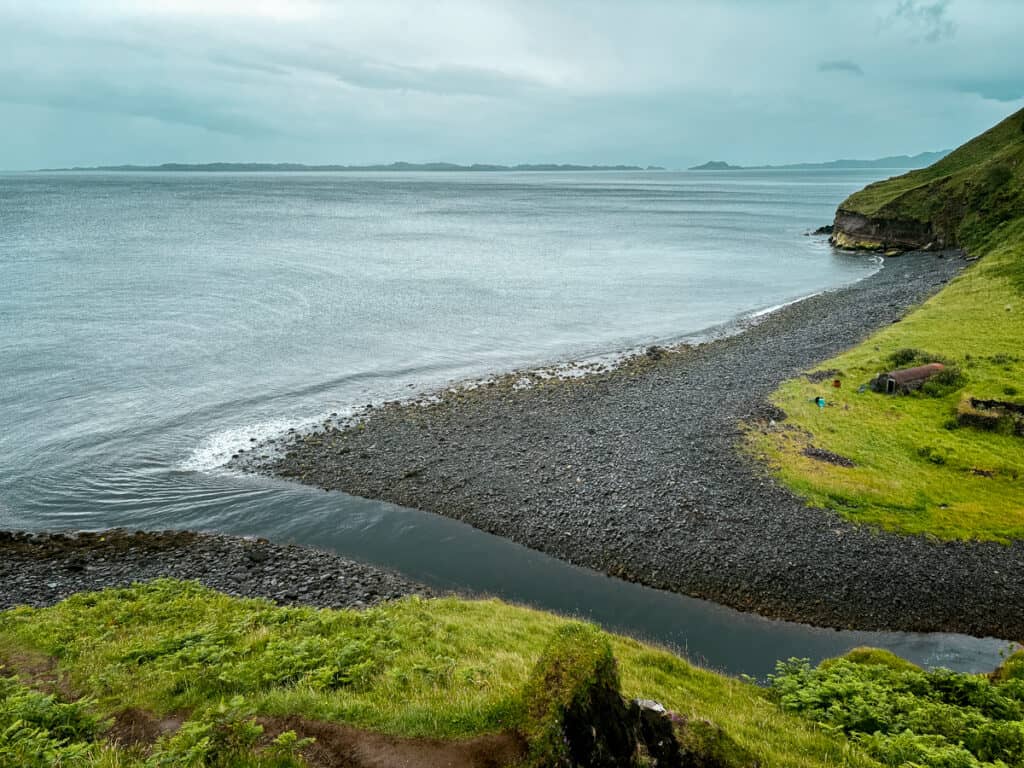
4. The Rise of the Scots
Between the Picts and the arrival of the Vikings, the Isle of Skye was primarily inhabited by the Scots, a Celtic people who originated from the kingdom of Dal Riata (in present-day western Scotland and northeastern Ireland). They are also referred to as the Gaels. By the 6th and 7th centuries, the Scots had begun to establish themselves in the Hebrides and along the west coast of Scotland.
The Scots were heavily influenced by the spread of Christianity, which significantly shaped their culture during this period. Monastic settlements and missionaries, such as St. Columba, were active throughout the region, helping to establish Christianity and creating links between the Scottish and Pictish kingdoms.
The Scots and the Picts coexisted for some time, and their cultures gradually began to merge, particularly after the union of their two kingdoms in the 9th century under Kenneth MacAlpin.
In the centuries between the decline of Pictish dominance and the Viking raids, the Scots of Dal Riata were key figures in Skye’s social and political life. However, like much of the western Highlands, the island remained relatively isolated and was primarily organised around small, clan-based communities.
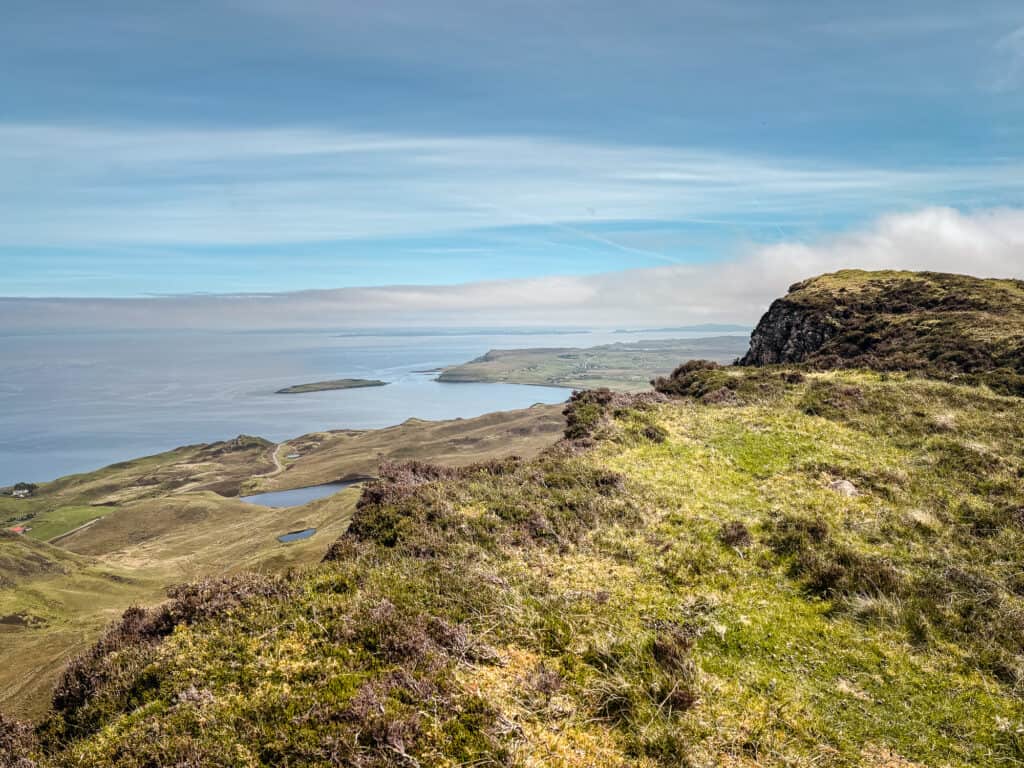
5. Viking Influence
The Vikings arrived in Skye around the 9th century, bringing a legacy of conquest, settlement, and cultural transformation.
These Norse invaders left an indelible mark on the island, influencing its culture, language, and even place names—many of which have Norse origins, such as Uig, which comes from the Old Norse word “Vík” meaning bay.
Battles between the Vikings and the Picts were common, with control of the island shifting hands multiple times throughout history. Skye eventually became part of the Kingdom of the Isles. This Norse-Gaelic realm ruled much of the Hebrides until the Treaty of Perth in 1266, formally bringing the islands under Scottish control. The Viking legacy on Skye also included changes in social structures, seafaring practices, and trade routes that would shape the island’s future.
Rubha an Dùnain, previously mentioned above, is also the site of a Viking village, including a “canal” from the loch to the sea that would have been used to ferry boats back and forth. You can walk from Glenbrittle to see it.

6. The Clans of Skye
The clans, particularly Clan MacLeod and Clan MacDonald, played defining roles in shaping Skye’s medieval history and identity.
Their histories are filled with tales of conflict, alliance, betrayal, and resilience. Feuds between the clans were frequent and often bloody, driven by disputes over territory, honour, and power.
The MacLeods and MacDonalds were not only involved in skirmishes on Skye but also broader Highland politics, making alliances with other clans and sometimes fighting in larger battles.
Clan culture involved strict loyalty to the clan chief, complex systems of kinship, and an enduring oral tradition of poetry and song, which helped preserve their stories through the centuries.
Castles like Dunvegan, Duntulm, and Armadale are not just picturesque ruins—they are remnants of Skye’s turbulent medieval past. These fortresses served as defensive strongholds and governance centres, where decisions about war, peace, and clan affairs were made.
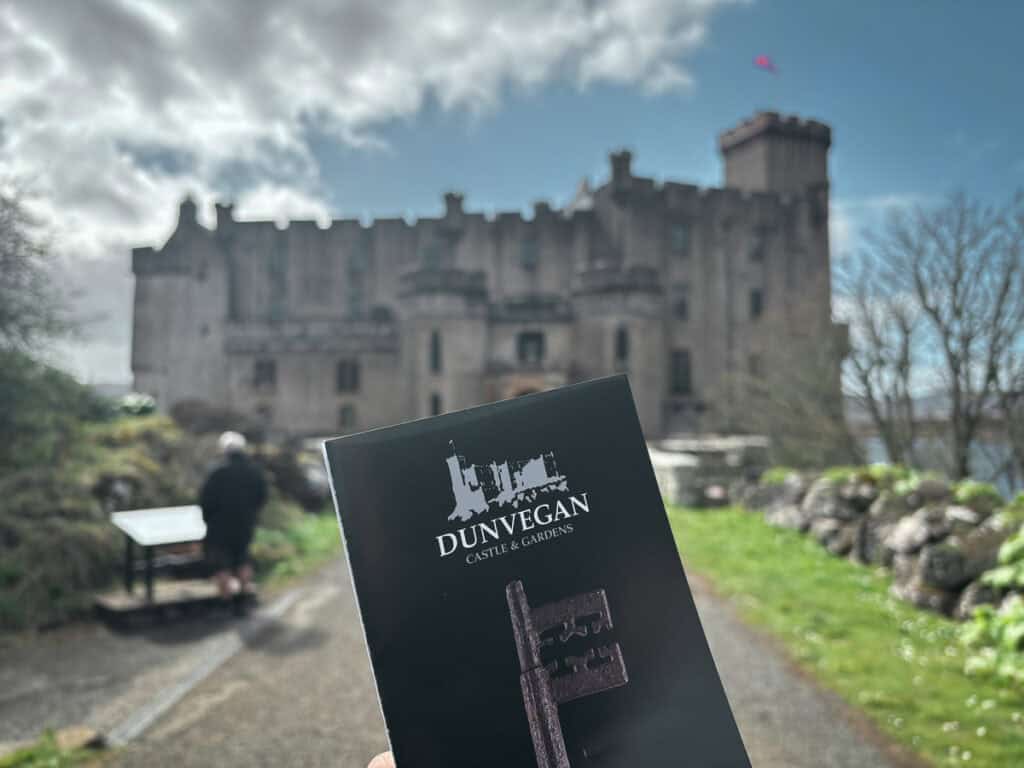
Each castle on Skye tells its own story of intrigue and power.
Dunvegan Castle: The oldest continuously inhabited castle in Scotland, has been the seat of Clan MacLeod for over 800 years. This fortress, perched on a rocky outcrop overlooking Loch Dunvegan, has withstood numerous sieges, clan battles, and periods of peace.
Duntulm Castle: Now a ruin, was once a stronghold of Clan MacDonald, strategically placed to control the surrounding seas.
Caisteal Camus: Originally a MacLeod stronghold. However, after several clan conflicts, it fell into the hands of Clan MacDonald of Sleat. The castle is now a ruin in southern Skye.
Caisteal Maol: Located near Kyleakin, this castle was the seat of Clan MacKinnon. It sits in a strategic spot near the Skye Bridge and was once used to control sea traffic and collect tolls. The castle now lies in ruins but remains an important symbol for Clan MacKinnon.
Dunscaith Castle: Located on a rocky promontory on the Sleat Peninsula, it was originally a fortress of Clan MacLeod but was later captured by Clan MacDonald of Sleat. This castle has deep ties to Skye’s legendary past as well, often associated with myths of the warrior Cú Chulainn in Irish and Scottish folklore. Though in ruins today, Dunscaith Castle offers stunning views and insight into the turbulent history of Skye’s clans.
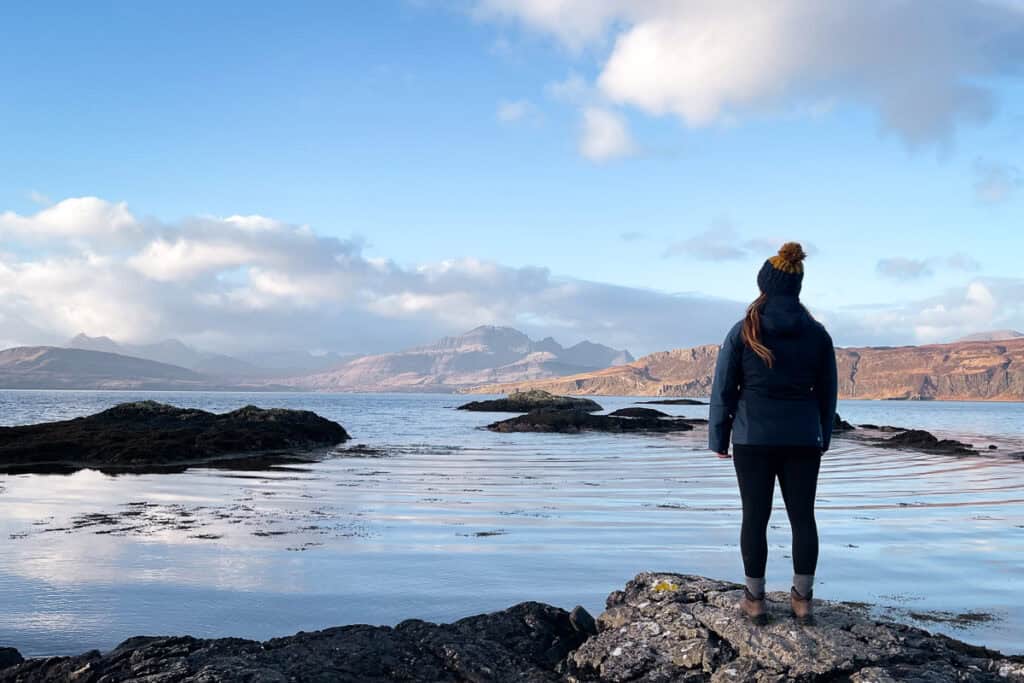
Hugh’s Castle: Also known as Caisteal Uisdean, it was built by Hugh MacDonald (Uisdean MacGhilleasbuig Chleirich) in the 16th century. Hugh was a rival claimant to the leadership of Clan MacDonald of Sleat and constructed the castle as his own stronghold. Located near the Trotternish Peninsula, Hugh’s Castle is now in ruins, but its history is filled with intrigue, including Hugh’s betrayal and subsequent imprisonment by his cousin, the clan chief. He died in captivity at Duntulm Castle.
Armadale Castle: Built in the early 19th century, around 1815. Clan MacDonald of Sleat constructed it as a grand manor house rather than a traditional medieval fortress, reflecting the shift in architectural styles during that period. While earlier fortifications existed on the site, the current structure was designed as part of a more modern estate for the clan chiefs.
The castle was abandoned as a residence in the 1920s and eventually fell into ruin. However, the estate remains a key site for MacDonald history, with the Museum of the Isles located on the grounds, showcasing the history of Clan MacDonald and the Isle of Skye. It represents the decline of the clan system and the adaptation to new ways of life in the 19th century.
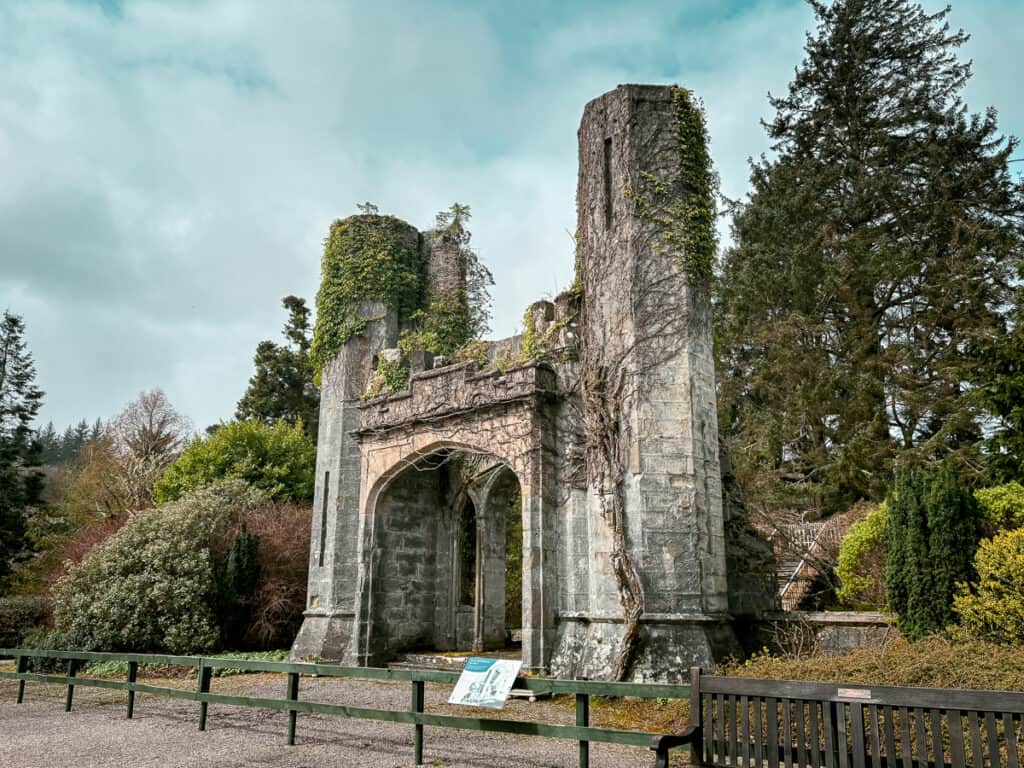
7. Jacobite Rebellions and Skye’s Role
The Isle of Skye played a notable role in the Jacobite uprisings of the 18th century, which sought to restore the Stuart monarchy to the British throne.
Most famously, Flora MacDonald, from South Uist, helped Bonnie Prince Charlie escape from Benencula, where she lived then, to the Skye after his defeat at the Battle of Culloden in 1746.
Disguised as her maid, the prince was ferried across the sea to Skye, an act immortalised in the Skye Boat Song. This haunting ballad echoes through Scottish history.
The daring escape is a key moment in Skye’s history and Scottish national identity, symbolising the romantic ideal of resistance and loyalty.
Flora MacDonald’s bravery is celebrated, but she faced arrest and imprisonment in London for her actions, reflecting the high stakes and divided loyalties of the time. In 1747, she was pardoned and returned to Skye before moving to North Carolina.
Later, she returned to Skye, where she died and was buried at Kilmuir. You can visit the large memorial there, just behind the Skye Museum of Island Life, which includes information about her story.
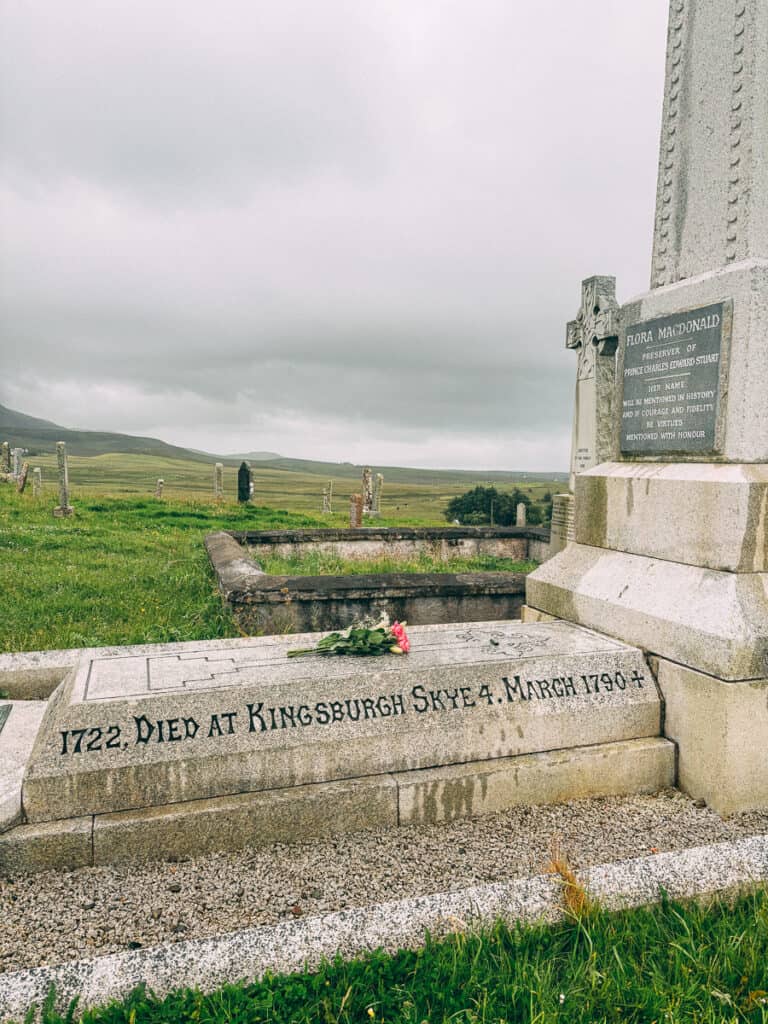
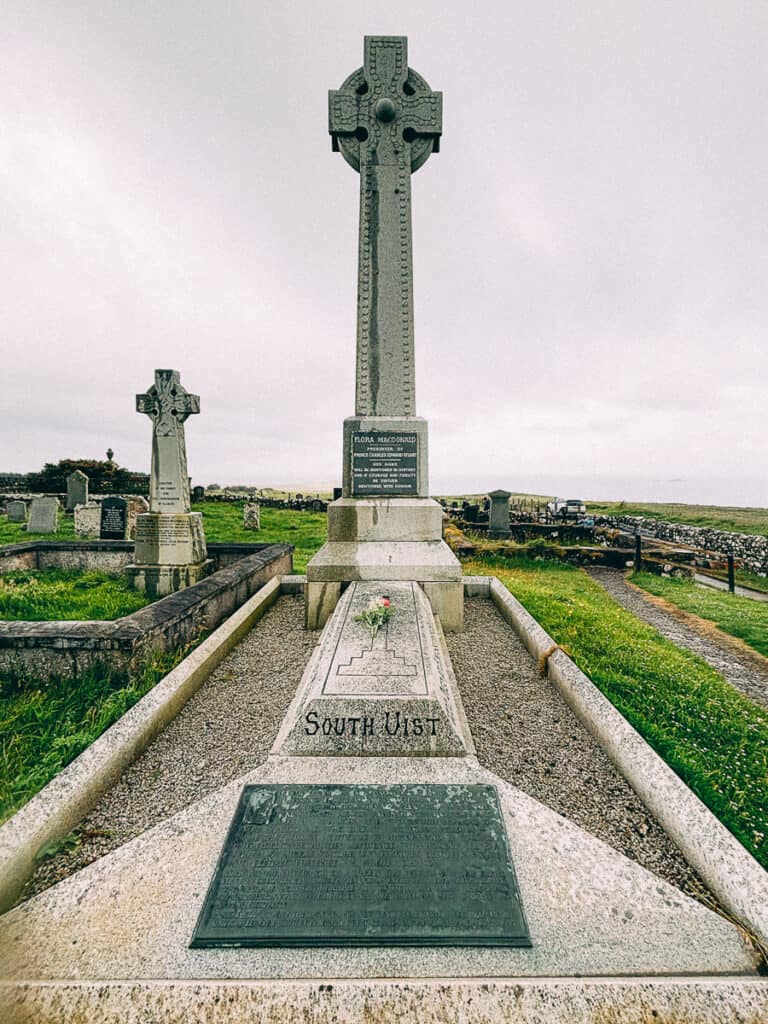
8. The Clearances
The Highland Clearances of the 18th and 19th centuries profoundly impacted Skye, forever altering its demographic and cultural landscape.
As landlords sought to replace tenant farmers with more profitable sheep farming, many Highlanders were forcibly evicted from their homes. This led to widespread emigration to North America, Australia, and beyond, where many Skye natives sought new lives.
The Clearances brought hardship, loss, and resentment that still resonates today. The ruined villages and abandoned crofts visible on Skye are poignant reminders of this dark chapter in its history.
The forced removal of families, coupled with oppressive rent practices, led to a decline in traditional Gaelic culture and language. However, this also gave rise to a diaspora that would carry the stories and traditions of Skye worldwide.
There are several locations of villages that were cleared that you can visit today, including Boreraig and Suisnish.
Boreraig is a haunting village that’s almost as it was when it was cleared in 1852. The village is now a mix of ruined stone houses along the shore of Loch Eishort. Suisnish is another village located nearby with atmospheric ruins that include roofless cottages and views over Loch Slapin. You can walk to both in a loop from the ruined church of Kilchrist on the road between Broadford and Torrin.
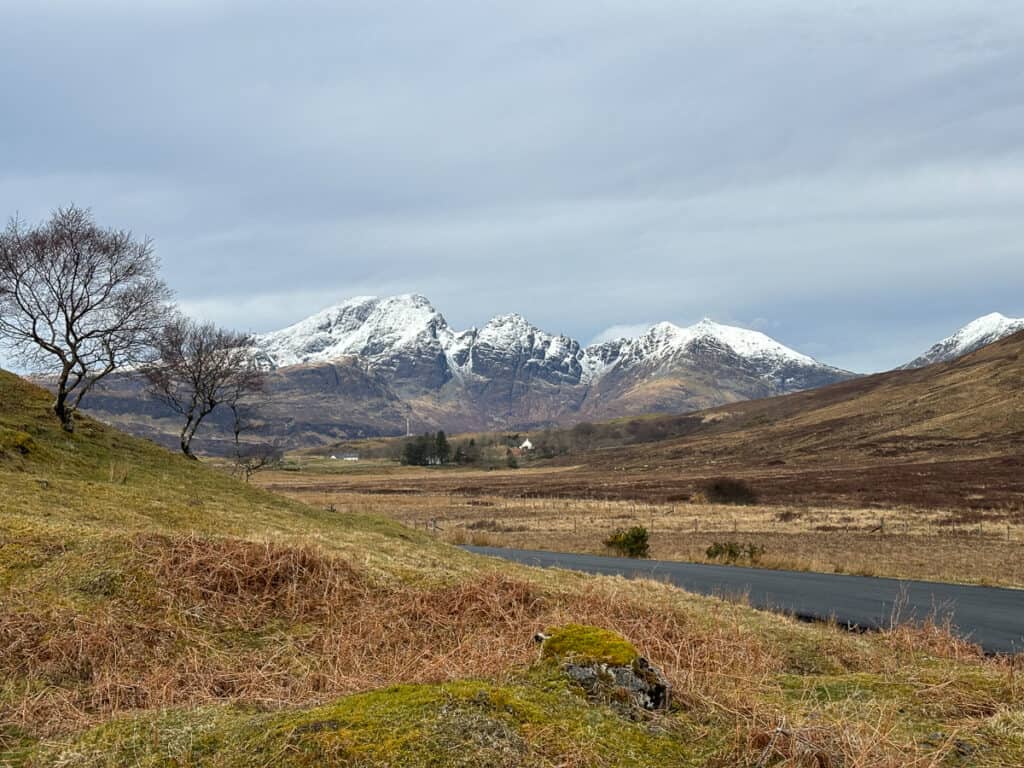
9. Skye into the 19th and 20th Centuries
The 19th and 20th centuries brought significant change and modernisation to Skye. The island began to develop infrastructure by introducing more roads, ferries, and, eventually, the Skye Bridge in 1995, which revolutionised access to the island by connecting it directly to the mainland.
These developments helped boost tourism and commerce, shaping Skye into the destination it is today while still retaining its remote and rugged charm.
During these centuries, Skye also saw changes in its social fabric, including a shift from a primarily agricultural economy to one increasingly reliant on tourism.
This has brought challenges, such as the need to balance development, preservation of Skye’s natural beauty and cultural heritage, and the ability to earn a living from visitors.
10. Gaelic Revival and Modern Skye
Skye has been at the heart of the Gaelic cultural revival in Scotland, particularly from the late 20th century onwards.
Efforts to preserve and promote Gaelic language, music, and traditions have been ongoing, with initiatives such as Sabhal Mòr Ostaig, the Gaelic college in Sleat, playing a significant role.
The college serves as a hub for Gaelic learning and cultural activities, drawing students from all over the world who are interested in this ancient language.
Gaelic Medium Education was also introduced to schools in 1985, and many children are now attending school in Gaelic (including ours!).
Skye’s modern cultural landscape is vibrant, with festivals, music, and literature celebrating its Gaelic heritage.
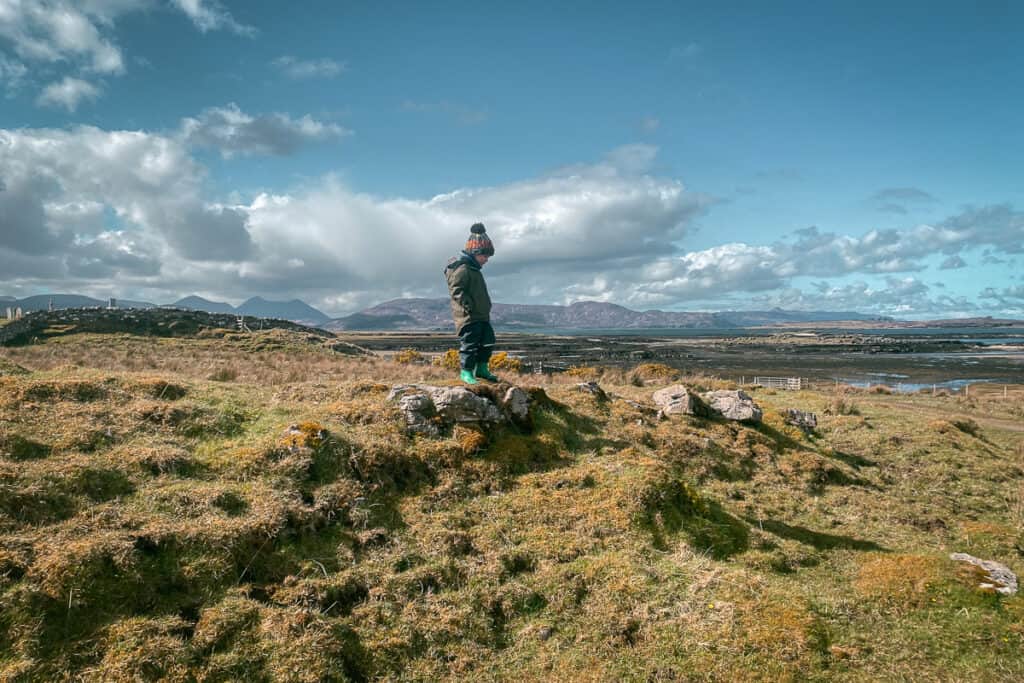
Today, Skye is a blend of the old and the new, where historical preservation meets contemporary life. Local communities and organisations are committed to preserving Skye’s history while adapting to the changing dynamics of modern tourism and development.
Efforts include restoring historical sites, promoting local Gaelic culture, and ensuring that the island’s natural and historical beauty is preserved amidst the growing number of visitors.
Modern Skye faces the challenge of maintaining its unique identity while navigating a future that balances heritage, sustainability, and economic growth.
The history of Skye is a rich and varied tapestry that tells the story of Scotland’s past. Skye’s history is filled with tales of conflict, survival, and cultural pride, from ancient settlers to powerful clans and Viking invaders to modern-day preservation efforts.
As you explore the Isle of Skye, take a moment to reflect on its history and the generations who have called this beautiful island home.
Sonja x
Experience Skye App
The Experience Skye App is like a tour guide in your pocket (or on your car radio!). It can tell you the history of Skye and provide information and stories about the popular places to visit.
I’d recommend it if you’re planning to self-drive around Skye or take public transport since it tells you more about the places you’ll be visiting.
You can use my code MISS10 for 10% off. Find out more here.







